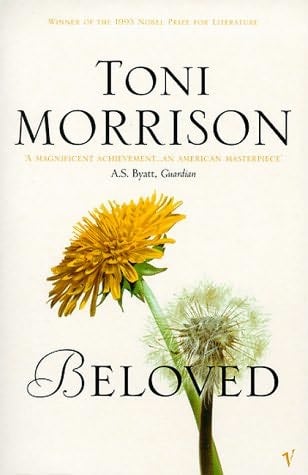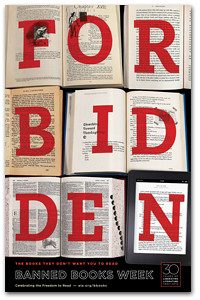In honor of Banned Books Week, the UGL graduate assistants (you may’ve seen them hanging out at the Research desk with an iPad, waiting to answer your questions) came up with a list of their favorite books that have spent time on various “banned” lists. If you’re looking for a “dangerous” read, here are a few suggestions:
 Chris recommends…
Chris recommends…
American Psycho by Bret Easton Ellis
American Psycho is a psychological thriller and social satire about vanity, materialism, and obsession. Set in 1980s Manhattan, the book follows the lives of young misanthropic investment bankers and their various transgressions. Upon the novel’s publication in Australia, its sale was restricted to adults (18+ years of age) and was banned outright in Australian states, such as Queensland, for its hyper-realistic scenes of sex and violence. Despite its disturbing content, Ellis’s prose is stylistically superior to most writers I’ve read. Imagine Vladimir Nabokov writing a Stephen King novel.
 Christina recommends…
Christina recommends…
Baby Be-Bop by Francesca Lia Block
Baby Be-Bop is the story of a young man coming to terms with his sexuality through a series of spectral visits from his deceased family members. It’s lyrical and beautiful and asserts that “Any love that is love is right.” It’s been challenged because some people apparently find the notion of teens being gay and confronting violence and prejudice to be “mentally and emotionally damaging;” some people even tried to sue their library, but they lost, of course.

Tad recommends…
The Color Purple by Alice Walker
The book is about Celie, who is healing from years of abuse from her father and her husband, “Mister.” The story is told through letters Celie writes to her sister, whom she has always tried to protect from a similar fate. Later, Celie finds that Mister has been hiding the letters her sister writes in return. Her rage and the support she finds in her friend Shug help her to question what it means to be a whole and loving person. The book has been banned and challenged repeatedly, primarily for language, sexual content (including descriptions of lesbian desire, as well as rape and incest), violence, and its depiction of race relations. It was banned from curricula in the Souderton, Pennsylvania, Area School District because it was considered “smut.”
 Rubayya recommends…
Rubayya recommends…
Frankenstein by Mary Shelley
Mary Shelley’s Frankenstein was banned in 1955 in South African Apartheid for being “objectionable and obscene.” Before this, beginning with the 1910 movie version, the story created controversy upon entering the American public imagination due to its God-like creation of life. Though Frankenstein is generally considered within the genre of horror, and the creation of a living being out of corpses is nothing short of horrific, it is also considered a major work of Gothic literature and science fiction.
Reading it as science fiction, my preferred reading, encourages the reader to ask which is worse: the horror of Victor Frankenstein’s creation or the consequences of its subsequent social abandonment? The world only sees the “monster” as a monster, despite his self-education and promise that he will remove himself from the populated world if only his creator will create for him a companion. Is it worse to give life to a human-like being made out of corpses or to deny it a perfectly reasonable and moral pursuit of happiness? I’ll leave that up to you to decide.
 Zoe recommends…
Zoe recommends…
The Giver by Lois Lowry
The Giver was number 11 on most banned or challenged books from 1990-1999—just as I was reading it and falling in love with the incredible characters and gripping story. The Giver tells the story of a young boy who is chosen to be the receiver of memory—all memory—in a utopian society that shows its true colors as the book progresses. It won a Newberry Medal in 1994 and yet still became one of the most banned books of the decade—perhaps because of the mystery ending, or perhaps because of the dystopian suggestions in the storyline. Yet the novel confronts growing up, overarching societal problems, and friendships that grow apart: things kids experience every day. The Giver is a part of a loose quartet of books, the last of which will be published within the year.
 Rachel recommends…
Rachel recommends…
Harry Potter series by J.K. Rowling
J.K. Rowling’s massively successful 7-part series depicting the wonderful world of wizardry topped the 100 “most challenged” books list for 2000-2009. Harry Potter, his magical friends and their wide array of adventures (everything from battling dark arts wizards to navigating teenage hormones) are widely credited as inspiring massive amounts of people to pick up books—children, teens and adults alike. However, the books were also heavily challenged on charges they encourage occult practices, discourage Christian religious beliefs and in some cases, promote evil. And though the overall story itself is excellent, it’s the small details Rowling embedded throughout that truly make these books a remarkable feat of imagination.
 Lily recommends…
Lily recommends…
The House of the Spirits by Isabel Allende
My banned pick is an all-time favorite of mine: The House of the Spirits, by Isabel Allende. The book is a classic of magical realism, following four generations of the same Chilean family through love, loss, and revolutionary upheaval. HotS, although a staple in many high school curricula, has been banned in Spanish and English due to sexually explicit language and some scenes of intense violence and cruelty. But Allende’s stunning character portrayals and the rich history she develops for the Trueba family makes any cringing worth your while. Easily one of the most thought-provoking and fruitful reads of my lifetime.
 Holly recommends…
Holly recommends…
The Hunger Games trilogy by Suzanne Collins
It never fails, if it’s a popular YA series, someone’s not going to like it. The Hunger Games trilogy follows Katniss Everdeen in a futuristic, dystopian world where the rich are surrounded by luxury, the poor are oppressed and starving, and the children are used a pawns to keep the masses subdued. Katniss is chosen to compete in the annual Hunger Games, where 24 children are forced to fight to the death. While battling for her life, she ignites a revolution no one can control. The series has been challenged over the last couple of years because of the books’ violence, sexuality, and language. I’ve read this series at least 3 times, straight through, and love it every time. My favorite things about it are the strong central female character, the sometimes-subtle social critique, and just because Suzanne Collins can tell a dang good story.
 Amanda recommends…
Amanda recommends…
The Perks of Being a Wallflower by Stephen Chbosky
Yes, this book was recently made into a movie. And yes, Emma Watson is in the movie. However, you should read the book anyway. Perks is written in letter form and tells the story of Charlie, an introverted kid who is starting high school and trying to cope with everything that goes along with that period in life. The book has been frequently challenged because it deals with suicide, drug use, homosexuality, and abuse of various sorts. I love Perks because it is a completely honest portrayal of the awkwardness of beginning high school and trying to find your place. And it has great lines like this one: “We accept the love we think we deserve.”
 Dan recommends…
Dan recommends…
Slaughterhouse-Five by Kurt Vonnegut
Slaughterhouse Five tells the story of Billy Pilgrim, a WWII veteran and survivor of the firebombing of Dresden, as he becomes unstuck in time, relives his past, and spends time as an exhibit in an alien zoo. Kurt Vonnegut’s dark comedic portrayal of wartime atrocities, along with sexually explicit content and strong language, have made the book the target of many a book banner, but what they miss is the strong underlying humanity that drives the book. Vonnegut’s novels are a perennial addiction for undergraduate book lovers everywhere, and this is a great place to start.
 Jennie recommends…
Jennie recommends…
To Kill a Mockingbird by Harper Lee
To Kill a Mockingbird follows 8-year-old Scout Finch; her brother, Jem; and their father, Atticus as the small Southern town of Maycomb, Alabama, where the novel takes place, is shaken by the arrest and eventual trial of a young black man accused of raping a white woman. When Atticus is called upon to defend the accused, Scout and Jem get caught up in events that are beyond their understanding as they try to make sense of the world they live in. To Kill a Mockingbird has been banned because it contains profanity and racial slurs and tackles racial themes. In spite of its history as a banned book, I love it because it is a poignant story about growing up, discovering what one believes in, and seeing the humanity in people who are different from us.
 Ashley recommends…
Ashley recommends…
A Wrinkle in Time by Madeleine L’Engle
A Wrinkle in Time was by apparently banned for challenging religious beliefs. This Newberry Award-winning book is strange and incredibly complex. It absolutely blew my mind when I read it as a kid; it’s no less enjoyable and thought-provoking now.




 Ashley recommends…
Ashley recommends… So, this may seem pretty obvious, but here at the UGL, we like books. Like, a lot. In fact, we like them so much, we think you should have access to any book you want—especially for educational and informational purposes. If it’s not at the UGL or one of UIUC’s other libraries, we’ll work to find it for you at another I-Share library or through Interlibrary Loan—or even the public libraries in town. Our Mission Statement (part of the
So, this may seem pretty obvious, but here at the UGL, we like books. Like, a lot. In fact, we like them so much, we think you should have access to any book you want—especially for educational and informational purposes. If it’s not at the UGL or one of UIUC’s other libraries, we’ll work to find it for you at another I-Share library or through Interlibrary Loan—or even the public libraries in town. Our Mission Statement (part of the